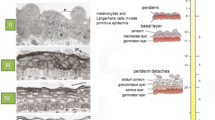Abstract
Fetal skin wounds heal without inflammation, collagen deposition or wound contraction. The mechanism of this process is unknown, but may be unique to fetal cells, the fetal environment, or an combination of both. In order to determine whether fetal cells are the only factor responsible for scarless wound healing, an experimental study was performed on ten cats who were in the last trimester of their pregnancy. Skin grafts were transferred from mother to fetus and fetus to mother. The fetal skin grafted to the mother was biopsied between the eighth and tenth postoperative days and was evaluated histopathologically on days 18–20. Biopsy revealed scar formation in both the fetal grafts in the adult and maternal grafts in the fetus. We can conclude that scarless wound healing in the fetus is not solely due to fetal cells.
Similar content being viewed by others
References
Dietesheim JA, Delozier JB, Rees RS, Broadley K, Davidson JM, Nanncy LB (1990) Covered fetal excisional wounds heal by tissue regeneration. Surg Forum 41:615–616
Hallock GG, Rice DC, Merkel JR, Dipaolo B (1988) Analysis of collagen content in the fetal wound. Ann Plast Surg 21:310–315
Haynes JH, Krummel TH, Schatzki PF, Flood LC, Cohen IK, Diegelman RF (1990) Histology of the open fetal rabbit wound. Surg Forum 41:558–560
Krummet TH, Nelson JM, Diegelmann RF, Lindblad WJ, Salzberg AM, Greefield LJ, Cohen K (1987) Fetal response to injury in the rabbit. J Pediatr Surg 22:640–643
Ledbetter SM, Morykwas MJ, Dietesheim JA, Vander Ark WD, La Rosee JR, Argenta LC (1991) The effects of total and partial amniotic fluid exclusion on excisional fetal rabbit wounds. Ann Plast Surg 27:139–143
Longaker MT, Adzick NS, Hall JL, Stair SE, Crombholme TM, Duncan BW, Bradley SM, Harrison MR, Stern R. Studies in fetal wound healing, VII. (1990) Fetal wound healing may be modulated by hyaluronic acid stimulating activity in amniotic fluid. J Pediatr Surg 25:430–433
Longaker MT, Harrison MR, Crombleholme TM, Langer JC, Decker M, Verrier ED, Spendlove R, Stern R (1989) Studies in fetal wound healing: I. A factor in fetal serum that stimulates deposition of hyaluronic acid. J Pediatr Surg 24:789–792
Longaker MT, Harrison MR, Langer JC, Crombleholme TM, Verrier ED, Spedlove R, Stern R (1989) Studies in fetal wound healing. A fetal environment accelarates fibroblast migration in vitro. J Pediatr Surg 24:793–798
Longaker MT, Whitby DJ, Adzick NS, Crombleholme TM, Langer JC, Duncan BW, Bradley SM, Stern R, Ferguson MWJ, Harrison MR (1990) Studies in fetal wound healing VI. Second and early third trimester fetal wounds demonstrate rapid collagen deposition without scar formation. J Pediatr Surg 25:63–69
Longaker MT, Whitby DJ, Ferguson MJW, Harrison MR, Crombleholme TM, Langer DJ, Cockrum KC, Verrier ED, Stern R (1989) Studies in fetal wound healing: III Early deposition of fibronectin distinguishes fetal from adult wound healing. J Pediatr Surg 24:799–805
Longaker MT, Whitby DJ, Ferguson MJW, Lorenz HP, Harrison MR, Adzick NS (1994) Adult skin fetal environment heals with scar formation. Ann Surg 219:65–72
Salman T, Güvenç BH, Çelik A, Altuğ T, Büyükdevrim AS (1990) Fetal intestinal transplantation in rats. Turk J Med Biol Res:167–169
Siebert JW, Burd AR, McCarthy JG, Weinzweig J, Ehrlich P (1990) Fetal wound healing: A biochemical study of scarless healing. Plast Reconstr Surg 85:495–503
Smith RJ, Xiao H, Rhee C, Sanus G, Jackson IT (1997) Longterm facial growth after endoscopic and open in-utero cleft lip repair in the fetal lamb model. Eur J Plast Surg 20:27–32
Somasundaram K, Prathap K (1970) Intra-uterine healing of skin wounds in rabbit foetuses. J Pathol 100:81–86
Author information
Authors and Affiliations
Rights and permissions
About this article
Cite this article
Çek, D.I., Özer, K., Perk, C. et al. Is fetal tissue the only factor responsible for the properties of fetal wound healing?. Eur J Plast Surg 21, 28–30 (1998). https://doi.org/10.1007/BF01152420
Received:
Accepted:
Issue Date:
DOI: https://doi.org/10.1007/BF01152420




